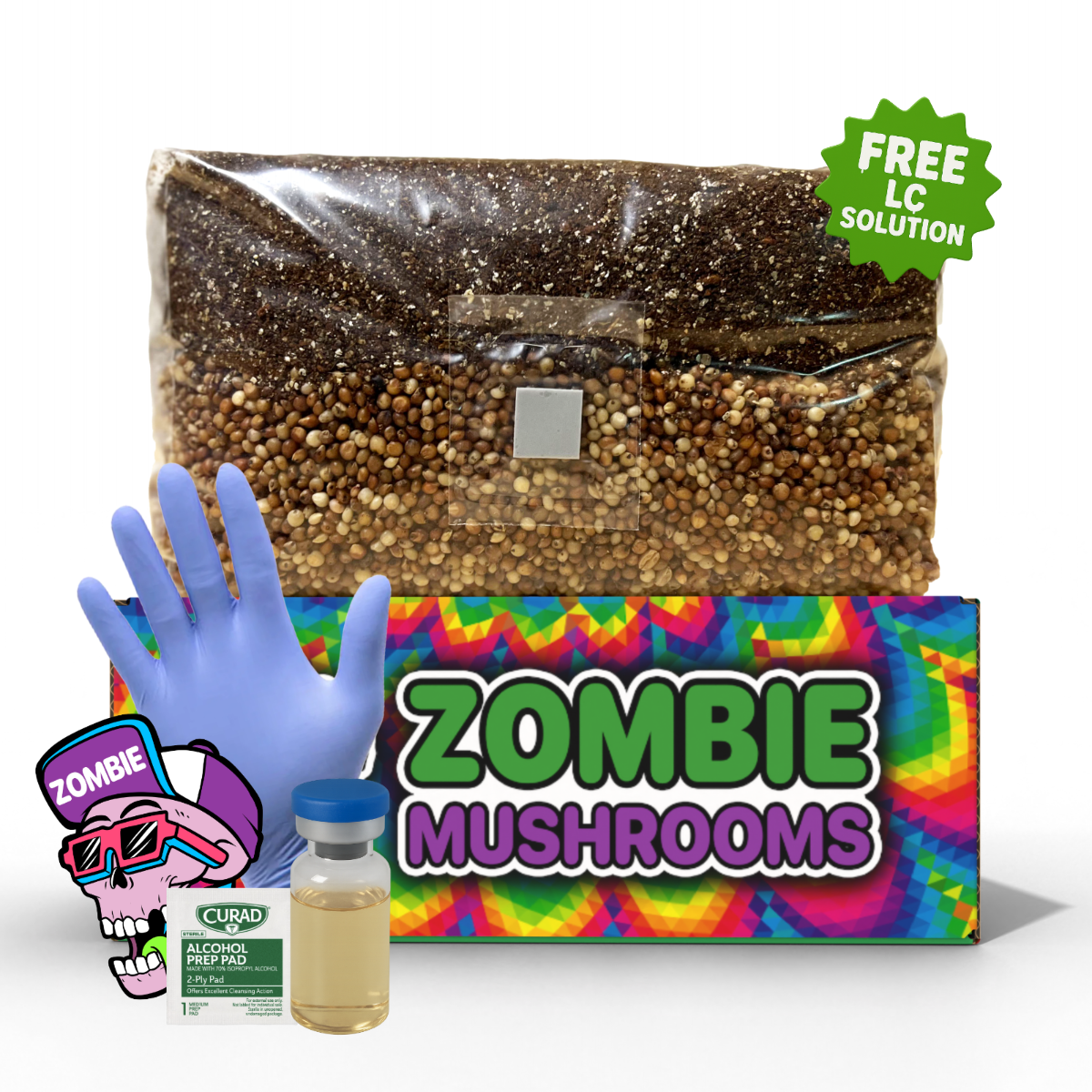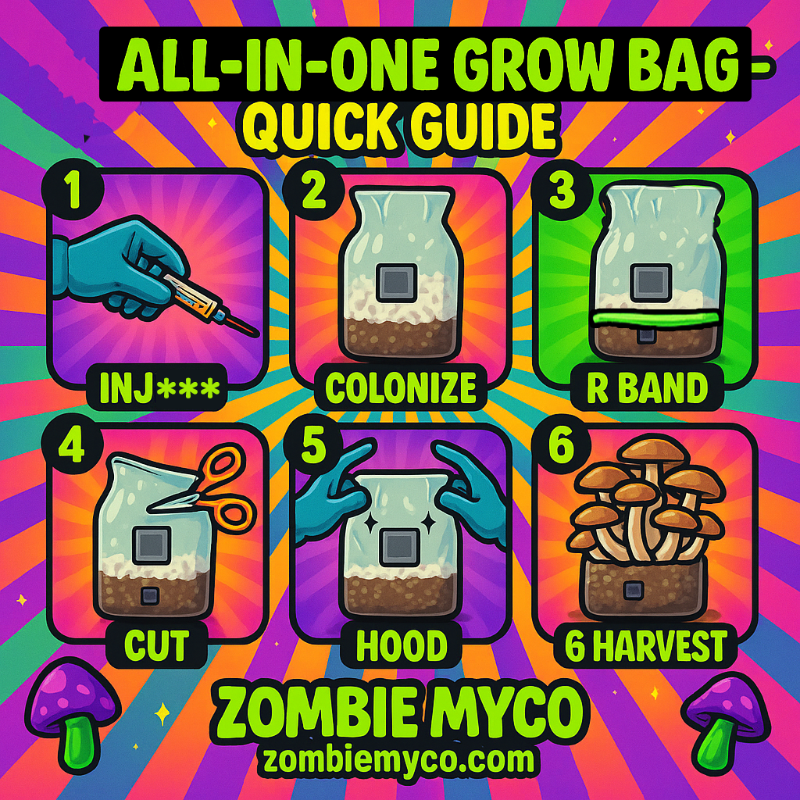⬇️ Prefer to listen instead? ⬇️
- AI technologies have boosted mushroom yields by predicting optimal environmental conditions and harvest timing.
- Robots like those from Tupu streamline harvesting, addressing labor shortages in mushroom farms.
- Machine learning models forecast mushroom performance based on historical and sensor data, reducing trial and error.
- AI guides substrate optimization, improving colonization rates and reducing waste in mushroom production.
- Advanced monitoring systems enhance success rates for complex species like turkey tail mushrooms.
Artificial intelligence is transforming mushroom cultivation through smart automation, data-driven decision making, and predictive technologies. Whether you're running a commercial grow room or a small home setup, AI-powered grow systems can help you optimize yield, reduce losses, and fine-tune grow conditions. Using tools like liquid culture jars and sensor-integrated grow bags, growers can monitor metrics like temperature, humidity, CO₂ in real time. This guide will break down how AI works in mushroom farming, its real benefits vs hype, and how to integrate AI methods safely and effectively for better crop performance.
How AI Works in Mushroom Farming
AI mushroom growing uses a mix of technologies. This includes machine learning, the Internet of Things (IoT), robots, and computer vision to make the growing process work best. Each of these parts does something important. They let growers automate tasks, find problems, and get better results overall.
For example
- Sensor networks & IoT: continuous monitoring of humidity, temperature, CO₂, light—letting ai-powered grow systems issue alerts or adjust for you.
- Machine Learning & Predictive Models: analyze past grow cycles to forecast yields, predict contamination risks, and optimize harvest timing.
- Substrate & Resource Optimization: algorithms suggest the best substrate mixes, grain spawn incubation settings, or moisture levels to speed up colonization and reduce waste.
- Automation & Robotics: for large operations, robotics or automated systems handle tasks like harvesting or adjusting airflow, lowering labor needs and helping maintain consistency.
Together, these tools create an AI system. It can learn from every mushroom growing cycle and get better with each harvest. This means farms can produce more. Also, they can keep product quality higher, react to what the market needs faster, and use fewer resources through careful management.
Machine Learning for Predicting Yield
One main plus of AI mushroom growing is predicting how much you'll get. Growing mushrooms the old way often meant trying things out to see what works, especially when growing a lot. But AI uses past and current data. It finds patterns that even skilled farmers might miss.
With machine learning, systems can
- Show how the growing material, temperature, moisture, and yield are related.
- Suggest the best times to harvest based on predictions.
- Test different growing plans and suggest the one that uses resources best.
The MUSHNOMICS project shows how useful this can be. Their programs use data to see when production might drop. They suggest ways to fix things before problems start. This leads to results that are easier to predict and more profitable.
As the system gets more data over time, it gets more exact and works better for local conditions. This is very helpful for growers in different climates, dealing with weather you can't predict, or growing unusual types that need special care.

Smart Sensors and Checking Conditions All the Time
Keeping the environment just right is key in growing mushrooms. Mushrooms are very sensitive to changes in temperature, humidity, CO₂ levels, and light. Too much or too little of one thing can really affect how fast they grow, how big they get, and even how they taste or their medicinal qualities.
AI systems, with IoT sensors, watch conditions all the time. This allows for very exact growing. These sensors collect lots of data every second. They measure temperature, humidity, air pressure, CO₂ amounts, and more. The AI then understands this data to
- Either change the system settings automatically (like increasing airflow or changing temperature),
- Or tell growers that they need to make changes by hand.
These smart systems mean you don't need to check visually all the time or use timers. Instead, you get exact, automatic control. For mushroom types like shiitake, lion’s mane, and white buttons—each needing different growing conditions—this careful level of control greatly increases the chances of growing them successfully.

AI and Automated Growing Systems
Growing everything automatically is not something for the future—it's happening now. Some companies are putting AI-powered mushroom farms into small units the size of shipping containers. One well-known example is Mycro Harvest. Their vertical farm units have controlled conditions managed closely by AI systems.
These smart farms can handle
- Airflow, to make sure CO₂ spreads correctly.
- Watering cycles, copying natural morning mist.
- Light schedules made for different growth stages.
- Resource use, including water and energy, for sustainability.
What's most interesting is that you can scale this up. These container farms can be stacked or put in cities. This cuts down on shipping costs and lets you grow all year closer to the people buying the mushrooms. For small farms, groups working together, or new farming tech companies, this setup offers a way to start without buying or renting lots of land.

Robots in the Mushroom Farm
Picking mushrooms is known for needing a lot of people. Mushrooms must be picked at just the right time. Pick them too early, and they don't have much flavor or nutrition. Pick them too late, and they start to go bad or release spores. Also, they are delicate, which makes using machines tricky.
This is where AI-powered robots come in.
Companies like Tupu have made robots that can
- Find mushrooms ready to pick using image recognition.
- Figure out the gentlest way and force to remove them.
- Record the size and weight of each picked mushroom to help the data system.
These robot pickers mean you don't need as many people. They can work all day and night. And they make the picking process more consistent, reducing mistakes that people might make. For commercial mushroom businesses dealing with fewer workers or needing to follow GMP (Good Manufacturing Practices) rules, robots can help with many problems.

Computer Vision for Monitoring and Finding Disease
Even if you control the conditions perfectly, diseases and pests can ruin a crop quickly. Computer vision brings a high-tech way to check crops. It's something farms used to do just by looking. Cameras, with AI software that looks at images, check mushroom beds often to find signs of trouble early.
Think of it like a farm worker who is always watching and never forgets anything
- Systems like MycoSense Spotlight look at images to find mold, colors that are wrong, or growth problems.
- The AI can tell growers about contamination before it spreads.
- Over time, the system gets better at telling the difference between harmless changes and real issues.
This not only means fewer losses but also frees up farmers. They don't have to check every single growing unit by hand.
Big Data and Systems to Help Make Decisions
AI technology isn't just for the physical growing space. At a higher level, "big data" systems look at information from many places. This includes harvest records, numbers about growing materials, weather reports for the area, and even what the market is doing.
Using tools made by projects like MUSHNOMICS, growers get useful information about
- Which growing materials have worked best in the past under certain conditions.
- When to start a new crop based on market predictions.
- How the resources used compare to what's normal in the area.
These systems that help with decisions don't take away the grower's job—but they can make it much better. With each cycle, growers make better choices, spend less time experimenting, and predict how much money they'll make with more certainty.

The Role of AI in Making Mushroom Growing Substrates Work Best
Mushroom growing substrates are key to success. Whether you use straw, sawdust, or coffee grounds, your substrate affects food for the fungi, how well it holds water, airflow, and how fast the mycelium grows.
AI helps make the best substrate mix in several ways
- Nutrient Profiles: Machine learning programs look at which substrate recipes led to the best mycelium growth and mushroom production.
- Moisture Balance: AI tracks how fast substrates dry out or hold water in certain conditions.
- Mycelium Health: Computer vision and sensor data can see how the mycelium is growing early on and suggest changes.
Substrates can even be made specifically for certain mushroom types. AI's ability to fine-tune things like pH balance or how small the substrate pieces are makes sure growers start with the best possible base every time.

Substrates to Watch: Top 10 AI-Optimized Mushroom Substrates
Here is a closer look at the ten growing materials most often made better by AI
- Straw – Easy to get, good amount of lignin, often used for oyster mushrooms.
- Sawdust – Works best for mushrooms that grow on wood; lion’s mane and shiitake like it.
- Coconut Coir – Light and doesn't mold easily; holds water very well.
- Coffee Grounds – Recycled waste that has a good amount of nitrogen.
- Soybean Hulls – High in protein, often mixed with sawdust for shiitake.
- Hardwood Pellets – Pressed together and easy to use, last a long time.
- Gypsum – Adds calcium and sulfur; it's more of an addition than the main material.
- Manure-Rich Compost – Full of nutrients but used more for portobellos and buttons.
- Vermiculite – Great for holding water and making the substrate mix lighter.
- Enriched Grain Blends – Combines moisture, lots of nutrients, and resistance to microbes.
AI systems keep improving how well these substrates work based on results from actual growing. This gives growers an advantage backed by data.

Can AI Help Grow Complex Fungi Species like Turkey Tail?
Turkey tail mushrooms (Trametes versicolor) are known for being good for health and having pretty rings of color—but they are hard to grow. They need mycelium to grow for longer, specific airflow, and careful choice of substrate.
AI systems are great for handling these difficult needs
- Keep humidity steady and higher during slow growth times.
- Change how often air is exchanged as CO₂ builds up.
- Track how the mycelium is growing over many weeks without needing someone to check.
- Tell owners about changes in the color or moisture levels of the substrate.
Using AI not only helps get more turkey tail mushrooms but also greatly increases the chances of growing them successfully the first time. This makes this valuable mushroom available to more small growers and people who grow at home.

Turkey Tail Mushroom Kits: Smart Buying Guide
If you are just starting, turkey tail mushroom kits are an easy way to begin. Thanks to better AI mushroom growing methods and making substrates work better, today's kits are much smarter and easier to use than ones from before.
Things to look for in a good turkey tail mushroom kit
- Substrates that already have spores based on mixes tested by AI.
- Clear instructions about humidity and temperature ranges.
- Reviews from users saying it was easy to use and gave good yields.
- Sellers who mention AI-backed mixes in product descriptions.
Top-rated kits found on Amazon or special shops often use the best methods found through AI research. You are not just buying spores—you are using the combined knowledge from hundreds of successful growing efforts.
FAQ
-
Do I need AI to grow mushrooms successfully at home?
Not strictly. Many growers succeed using classic teks and good environmental control. AI adds precision and can reduce failures, but is most helpful for scaling or optimizing. -
What are AI-powered grow systems and sensor grow bags?
Grow systems with built-in sensors (for humidity, temp, CO₂) + connected software to collect data. Sensor grow bags may include filter patches and embedded sensors or work in controlled environments where these measurements matter. -
How much will AI tools cost vs manual methods?
Entry-level sensors and simple automation are affordable. More advanced robotics, machine vision, or commercial scale tools are expensive. Return depends on scale and how well you use and maintain them. -
Can AI reduce contamination or failed colonizations?
Yes—when combined with good technique. AI can alert you to changes (like humidity dips or abnormal growth patterns) that allow you to intervene early. -
Are there privacy or reliability concerns with AI systems?
Some. If your system relies on cloud data or 3rd-party software, privacy may be a concern. Also, sensors and hardware failures can mislead or cause problems if not monitored.
Limitations and Barriers to Entry
Even with the good things AI offers, there are real concerns about whether everyone can use it in mushroom farming:Upfront Cost
Equipment like sensors, cameras, and robots can be very expensive at first. This might be too much for small personal farms.
Learning Curve
The systems can need technical knowledge to set up, adjust, or fix problems. This can slow down people who don't have experience with technology.
Data Concerns
AI platforms that use the internet often need to get data from the farm. Not all growers feel comfortable sharing this, especially if the system is owned by a company.
But many of these systems are made of parts. Starting with a simple digital humidity controller or an AI-optimized mushroom kit lets growers see real benefits without needing to automate everything at once. It's more like taking steps than jumping in.
Future Trends in AI Mushroom Cultivation
AI mushroom growing is still pretty new. Here's what is likely coming next
- Algorithms Aware of the Market – AI that suggests which mushrooms to grow based on current prices, how much people want, and weather predictions.
- Autonomous Farms – Fully automated spaces where AI manages everything from spores to shipping with very little human help.
- Easier User Experience – Apps and simple interfaces will make AI mushroom growing easier for people who aren't tech experts.
Think of these new things less as replacing growers, and more as powerful tools that help more people get involved and make money in mushroom farming.
Is AI a Game-Changer or Just Growing Buzz?
AI in mushroom growing is not just talk—it is a real change in how fungi are grown, managed, and improved to get more yield, be more sustainable, and be easier to access. While fully adopting it might mostly be for bigger businesses, tools you can scale like computer vision monitoring, AI-improved mushroom growing substrates, and turkey tail mushroom kits create ways for everyone to start. This includes people growing in their backyards and new vertical farm businesses.
Use what fits your size and skill level. Every sensor, dashboard, or smart substrate you add moves you closer to being more efficient, getting better yields, and finding new ways forward for farming fungi.



